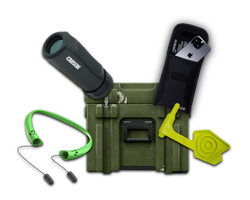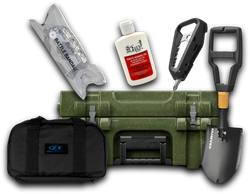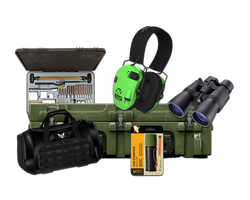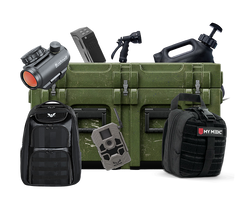Is It Safe to Shoot Steel Targets? A Comprehensive Guide
Table of Contents
- Introduction
- Understanding Steel Targets
- Safety Guidelines for Shooting Steel Targets
- Techniques for Safe Shooting
- Crate Club’s Commitment to Safety and Quality
- Conclusion
- FAQ
Introduction
Imagine the exhilarating sound of a bullet striking steel, echoing across a range, signaling a perfect hit. For many shooting enthusiasts, the appeal of steel targets lies in their durability and the immediate feedback they provide. However, this enjoyment is often accompanied by a lingering question: Is it safe to shoot steel targets? Whether you’re a seasoned shooter or a newcomer to the sport, understanding the intricacies of shooting steel targets is crucial for ensuring safety and maximizing your experience.
Shooting steel targets has gained popularity over the years, thanks to their longevity compared to traditional paper targets. However, with this popularity comes a responsibility to educate oneself about the potential risks involved. Misconceptions abound, often leading to unnecessary fears about ricochets and safety hazards. The truth is that, when used correctly, steel targets can be an enjoyable and safe component of your shooting practice.
In this blog post, we will explore the fundamental aspects of shooting steel targets, focusing on safety guidelines, types of steel, proper ammunition, and techniques to minimize risks. By the end of this article, you will have a comprehensive understanding of how to safely enjoy shooting steel targets while honing your skills. We'll also highlight how Crate Club's curated gear can enhance your shooting experience, ensuring you are well-prepared and equipped.
Understanding Steel Targets
The Appeal of Steel Targets
Steel targets have long been favored by shooters for several reasons:
- Durability: Unlike paper targets, which require constant replacement, steel targets can withstand thousands of rounds without degrading significantly.
- Feedback: The distinct ring produced upon impact provides immediate auditory feedback, helping shooters gauge their accuracy.
- Variety: Steel targets come in various shapes and sizes, offering a diverse shooting experience.
Types of Steel Used in Targets
The most commonly used steel for shooting targets is AR500, a high-carbon steel known for its exceptional hardness and resistance to impact. Here are some key characteristics of AR500 and its counterpart, AR550:
- AR500 Steel: This steel is rated for handling a wide range of calibers and is the standard choice for most steel targets. It is designed to absorb and disperse the energy of the bullet upon impact effectively.
- AR550 Steel: A step up from AR500, AR550 offers increased hardness and is better suited for high-velocity rounds. This steel is ideal for shooters looking for a target that can withstand the rigors of rifle shooting.
The Role of Target Design
The design of steel targets also plays a significant role in safety. Targets that are designed to swing or fall upon impact can help mitigate ricochet risks, as they redirect the energy of the bullet downward or away from the shooter.
Safety Guidelines for Shooting Steel Targets
Use the Right Ammunition
One of the most critical aspects of shooting steel targets safely is selecting the appropriate ammunition. Here are some key considerations:
- Full Metal Jacket (FMJ): FMJ rounds are generally the safest choice for shooting steel targets. They are less likely to fragment upon impact compared to softer lead rounds.
- Avoid Armor-Piercing and Steel-Cored Rounds: These types of ammunition can penetrate or cause excessive wear on steel targets, increasing the risk of ricochet. Stick to softer bullets that are less likely to cause damage.
Maintain a Safe Distance
Distance is crucial when shooting steel targets. The recommended distances vary depending on the type of firearm being used:
- Handguns: Maintain a minimum distance of 10 to 25 yards from the target.
- Shotguns: Stand at least 25 yards away.
- Rifles: Keep a safe distance of at least 100 yards from the target.
By adhering to these guidelines, you significantly reduce the risk of being struck by ricocheting fragments.
Inspect Your Targets Regularly
Before each shooting session, inspect your steel targets for any signs of damage. Targets that have dents, pits, or extensive wear may not effectively absorb bullet impacts, increasing the risk of ricochet. If you notice any damage, replace or repair the target before use.
Angle Your Targets
Properly angling your steel targets can further enhance safety. Targets should be positioned at a downward angle to ensure that bullets deflect towards the ground upon impact. This setup helps to minimize the chances of ricochets traveling back toward the shooter.
Wear Protective Gear
Always prioritize safety by wearing appropriate protective gear while shooting. This includes:
- Eye Protection: Safety glasses with side shields are essential to protect against flying fragments.
- Ear Protection: Use earmuffs or earplugs to shield your hearing from the loud sounds of gunfire.
It’s also a good idea to wear clothing that covers your arms and legs to minimize exposure to potential shrapnel.
Techniques for Safe Shooting
Practice Good Shooting Etiquette
Always follow standard firearm safety rules when shooting steel targets:
- Treat every firearm as if it is loaded: Always assume a gun is loaded and handle it with care.
- Keep the muzzle pointed in a safe direction: Ensure the barrel is directed away from yourself and others.
- Identify your target and what lies beyond it: Ensure that your target area is clear of people or animals before firing.
Be Mindful of Your Shooting Environment
Choose a shooting location that is open and free from obstacles. Avoid shooting in areas where there are structures or objects that could cause bullets to ricochet unpredictably. Setting up your shooting range in a controlled environment reduces the risk of accidents significantly.
Use a Spotter
Having a spotter can enhance safety during shooting sessions. A spotter can help observe impacts, provide feedback, and monitor the surroundings, allowing the shooter to focus on targeting while ensuring that safety remains a priority.
Crate Club’s Commitment to Safety and Quality
At Crate Club, we understand the importance of having high-quality, reliable gear for your shooting experience. Our subscription service delivers an array of curated tactical and survival tools designed to enhance your preparedness and enjoyment. By subscribing to Crate Club, you gain access to premium gear that includes:
- High-Quality Steel Targets: Our selection includes AR500 and AR550 steel targets, ensuring you have the best materials for safe shooting.
- Essential Safety Gear: From eye protection to tactical gloves, Crate Club offers products that enhance your safety during shooting activities.
- Expert Guidance: Each month, we provide tips and resources to help you improve your shooting skills and maintain safety.
Discover the benefits of being part of the Crate Club community and equip yourself with products that reflect our commitment to quality and preparedness. To learn more, visit our Crate Club Subscription Services page.
Conclusion
Shooting steel targets can be an incredibly rewarding and enjoyable experience when approached with the right knowledge and precautions. By understanding the risks, adhering to safety guidelines, and using quality gear, you can minimize potential hazards and focus on honing your shooting skills. Remember, the key to safe shooting lies not just in the equipment used but also in the practices followed.
As you prepare for your next shooting session, consider exploring Crate Club's curated selection of tactical gear and safety equipment. With the right preparation and mindset, you can confidently enjoy the thrill of shooting steel targets while ensuring your safety and the safety of those around you.
FAQ
Is shooting steel targets dangerous?
When proper precautions are followed, shooting steel targets is relatively safe. Using the correct ammunition, maintaining a safe distance, and inspecting targets regularly can significantly reduce the risk of accidents.
What type of ammunition is best for shooting steel targets?
Full Metal Jacket (FMJ) ammunition is recommended for shooting steel targets. Avoid armor-piercing and steel-cored rounds, as they can cause excessive damage and increase ricochet risks.
How far should I stand from a steel target when shooting?
The recommended distances vary: at least 10 to 25 yards for handguns, 25 yards for shotguns, and 100 yards for rifles.
What should I do if my steel target is damaged?
If your steel target shows signs of damage, such as dents or pits, replace or repair it before using it again to ensure safety.
Can I use steel targets in any weather condition?
Yes, steel targets are designed to withstand various weather conditions. However, ensure that the shooting environment is safe and that you take necessary precautions, such as avoiding shooting in wet conditions that may affect visibility.
Incorporating these practices will not only enhance your shooting experience but also foster a culture of safety and preparedness within the shooting community.
Share this article



